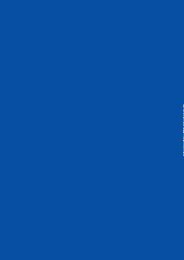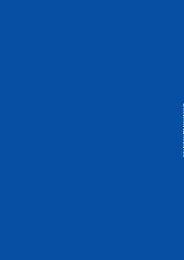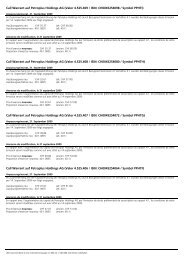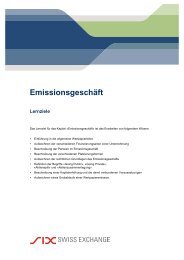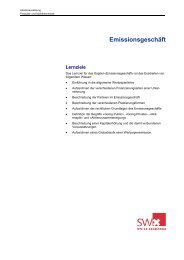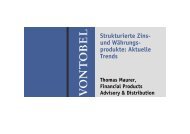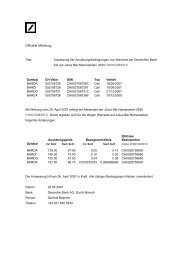Swiss Medtech Report 2012 - Medtech Switzerland
Swiss Medtech Report 2012 - Medtech Switzerland
Swiss Medtech Report 2012 - Medtech Switzerland
- No tags were found...
You also want an ePaper? Increase the reach of your titles
YUMPU automatically turns print PDFs into web optimized ePapers that Google loves.
The market counts<br />
The <strong>Swiss</strong> medtech industry is characterized by its short access process<br />
and its market-friendly reimbursement practice.<br />
<strong>Medtech</strong> companies achieve more than half their<br />
sales with products that are no more than three years<br />
old. For a new medical device to be sold in the <strong>Swiss</strong><br />
market quickly, it still does not have to undergo a<br />
time-consuming official approval process like the<br />
one for drugs. Rather, a declaration by the manufacture<br />
of the product’s conformity with the applicable<br />
standards must be submitted, and the medical device<br />
must be labeled in accordance with CE regulations.<br />
For certain non-hazardous medical devices (in<br />
Class I), the review of conformity may be undertaken<br />
by the manufacturer itself. For those with a<br />
higher risk potential, it must call in an external,<br />
government-certified and recognized conformity<br />
assessment body (also called a Notified Body). Under<br />
the Bilateral Treaties 1, <strong>Switzerland</strong> has agreed<br />
with the EU on the reciprocal recognition of their<br />
conformity assessment bodies. Thus the 5 Notified<br />
Bodies recognized by the <strong>Swiss</strong> accreditation body<br />
SAS and the 76 internationally accredited Notified<br />
Bodies of signatory states may be used.<br />
The standards applicable in <strong>Switzerland</strong> are to be<br />
found mainly in Federal Law 1 on Drugs and Medical<br />
devices (Therapeutic Products Act – “Heilmittelgesetz”),<br />
in the <strong>Swiss</strong> Regulation on Medical De-<br />
v ices (Medizinprodukteverordnung) and in the Reg -<br />
ulation on Clinical Trials with Therapeutic Products.<br />
FREELY NEGOTIaTED PRICEs In contrast<br />
to the reimbursement for drugs or medications by<br />
the compulsory health insurance (OKP), there is in<br />
principle no approved list for medical devices. Nor<br />
are the prices set by the government, but instead<br />
freely negotiated in a market that is upstream of<br />
the healthcare market. Therefore, service providers<br />
Institutions which might be of interest to you<br />
buchs&sachsse<br />
Innovations-Kommunikation<br />
20<br />
buchs&sachsse<br />
4153 Reinach<br />
www.buchs-sachsse.ch<br />
Creapole SA<br />
2800 Délemont<br />
www.creapole.ch<br />
DePuy Synthes<br />
www.depuysynthes.com<br />
Hocoma<br />
8604 Volketswil<br />
www.hocoma.com<br />
such as hospitals and physicians can in principle<br />
decide for themselves which products they will use,<br />
and pass the cost on to the health insurers as part of<br />
their services to the patient.<br />
EFFECTIvE, ExPEDIENT aND ECONO-<br />
MICaL The insurers are obliged to reimburse<br />
the services described in the Health Insurance Act<br />
(Krankenversicherungs-Gesetz) such as examinations<br />
conducted in hospitals, treatment or care services<br />
(cf. Art. 25 ff. Health Insurance Act). These<br />
must be effective, expedient and economical, i.e. the<br />
so-called “EEE” criteria must be fulfilled (Art. 32<br />
Par. 1 Health Insurance Act), which is, in principle,<br />
assumed. In this system, health insurers generally<br />
do not pay for medical devices as a separate<br />
item, but rather as part of prices that are negotiated<br />
among service providers (doctors, hospitals, etc.).<br />
TARMED – the price schedule for individual medical<br />
services – covers the outpatient sector. For acute<br />
somatic services provided in an inpatient setting,<br />
the diagnosis-related case-based rates pursuant to<br />
the <strong>Swiss</strong>DRG have applied since the beginning<br />
of <strong>2012</strong>. This means that costs are no longer reimbursed,<br />
but rather clearly defined medical services.<br />
ExCEPTIONs The exception to the reimbursement<br />
prac tice is materials and items (such as bandages,<br />
measuring devices, stoma supplies, incontinence,<br />
hearing, and vision aids) used by the insured<br />
person at a doctor’s prescription but without the aid<br />
of professionals (Art. 55 Health Insurance Regulation).<br />
For these there is a positive list of materials<br />
and items (MiGeL), with reimbursable product<br />
groups. MiGeL lays down a maximum reimbursement<br />
amount that the compulsory insurance must<br />
pay for each product.<br />
ISS AG<br />
2562 Port<br />
www.iss-ag.ch<br />
Straumann Holding AG<br />
4052 Basel<br />
www.straumann.com<br />
Ziemer AG<br />
2562 Port<br />
www.ziemergroup.com



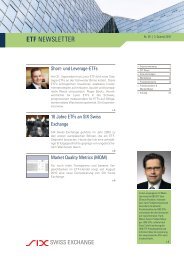
![Formular für nicht regulierte Unternehmen[pdf] - SIX Swiss Exchange](https://img.yumpu.com/21559295/1/184x260/formular-fur-nicht-regulierte-unternehmenpdf-six-swiss-exchange.jpg?quality=85)
![Gastbeitrag[pdf] - SIX Swiss Exchange](https://img.yumpu.com/21558666/1/184x260/gastbeitragpdf-six-swiss-exchange.jpg?quality=85)

